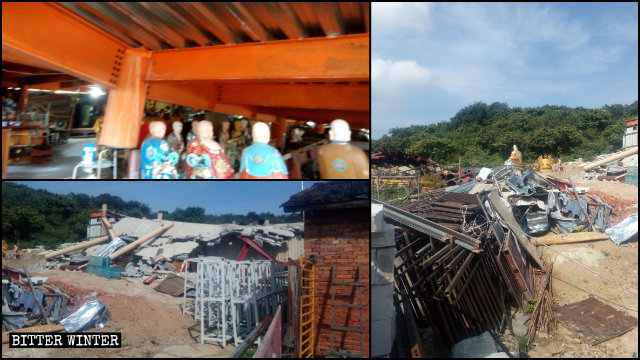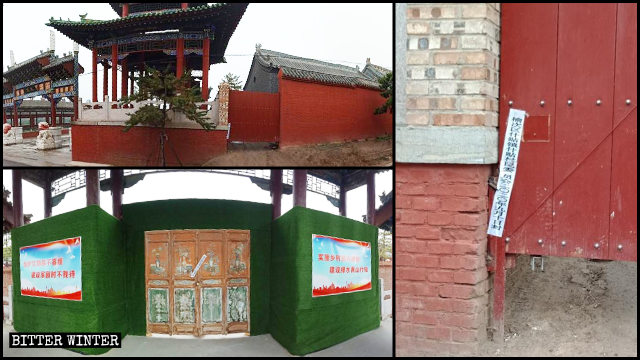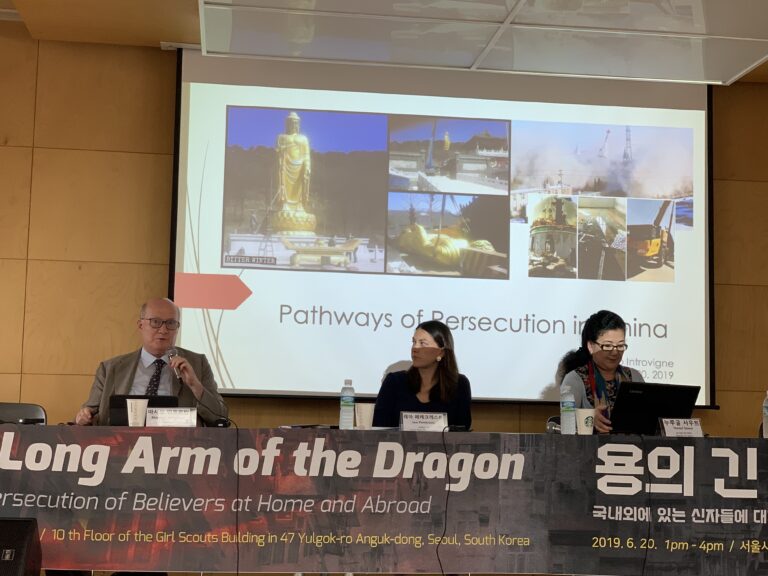The CCP continues crackdowns on traditional Chinese places of worship and religious icons.
by Zhang Feng
The Tianyiyuan Temple in Gushan town in the Jin’an district of Fuzhou, the capital of the southeastern province of Fujian, was demolished on June 30 because the local authorities requisitioned the land on which it stood. The Taoist temple spanned a history of 600 years and was an important religious venue in the area.
“Top town officials brought about 50 police officers, who surrounded the temple, and then workers demolished it with an excavator,” an eyewitness recalled.
On October 10, the Shanggan town government in Fuzhou’s Minhou county demolished the Taoist Pangu Emperor Temple to give way for road construction.
The Buddhist Fushou Temple, built in 1992 in Fuzhou’s Cangshan district, was leveled to the ground on June 27 on the pretext of “building an expressway.” The temple owner also had a second venue, a 600-square-meter temple on the Longyan Mountain in the district, built last year with the government’s approval. The new temple was destroyed in June as well because the authorities claimed that it “illegally occupied forestland.” The Buddhist suffered a loss of over 1.1 million RMB (about $ 168,000).

“I was crushed when both temples were demolished,” the Buddhist said in grief.

Some halls belonging to the Guanyin Pavilion, a Buddhist temple on the Guangfu Mountain in the Cangshan district, were demolished in April to implement the local government’s plan to build a new road. At 4 a.m. on the demolition day, all the intersections leading to the temple were blocked, and over 100 security guards secured the site. A local Buddhist said that the temple director managed to remove all Buddhist statues, but most valuables worth over one million RMB (about $ 150,000) were buried in ruins.

On September 10, the Jinzhong city government in the northern province of Shanxi shut down the Thousand Buddha Temple, which was under construction, claiming that the temple lacked proper building certificates and occupied arable land. A month before, the city’s Religious Affairs Bureau ordered to remove the temple’s signboard and three Buddhist statues at its entrance. Local Buddhists worry that the temple will be demolished eventually.

“Religious Affairs Bureau officials visited the temple several times, threatening to demolish it, and there is nothing we can do about it,” a Buddhist said.

In April, authorities destroyed a Bodhisattva statue outside the Shuilu Temple in Dongshagou village administered by Wujinshan town in Jinzhong’s Yuci district. “A local official said that the government orders to destroy all statues taller than ten meters,” a village Buddhist recalled.

In July, the government of Shanxi’s Shuozhou city shut down a Buddhist hall in an urban residence, claiming that it was illegal because it didn’t have a religious activity venue registration certificate. Officials threatened to arrest its director and everyone who dared to gather in the hall again. Local Buddhists believe that the venue, built with their donations, is legal because the city’s Religious Affairs Bureau has approved it.
In early July, the Chang’an district government in Xi’an, the capital of the northwestern province of Shaanxi, ordered to demolish a white-marble three-faced Guanyin statue outside the Guanyin Temple on Zhongnan Mountain because its construction was not approved. The demolition of the 16-meter-tall statue, built in 2002, lasted for over a month.

Over 300 public security and special police officers guarded the site to prevent people from interfering. All the roads leading to the statue were blocked. A demolition worker was detained for 15 days for taking photos and posting them online.
According to mainland China media reports, the news about the statue demolition attracted the attention of Buddhist circles at home and abroad. Professor Li Li’an, Director of the Buddhist Research Institute at the Northwest University in Shaanxi, called on relevant government departments to stop the demolition, explaining the cultural and religious importance of this icon. But to no avail.
“I can’t figure out why the government cracks down on this Buddhist statue. It’s against people’s will, so deeply unpopular,” a Chang’an district resident said.
Bitter Winter previously reported that on December 1, 2018, the Dragon King palace hall at the Zhongnan Mountain Guanyin Buddhist Monastery was destroyed under the guise of being an illegal building.
Source: Bitter Winter












